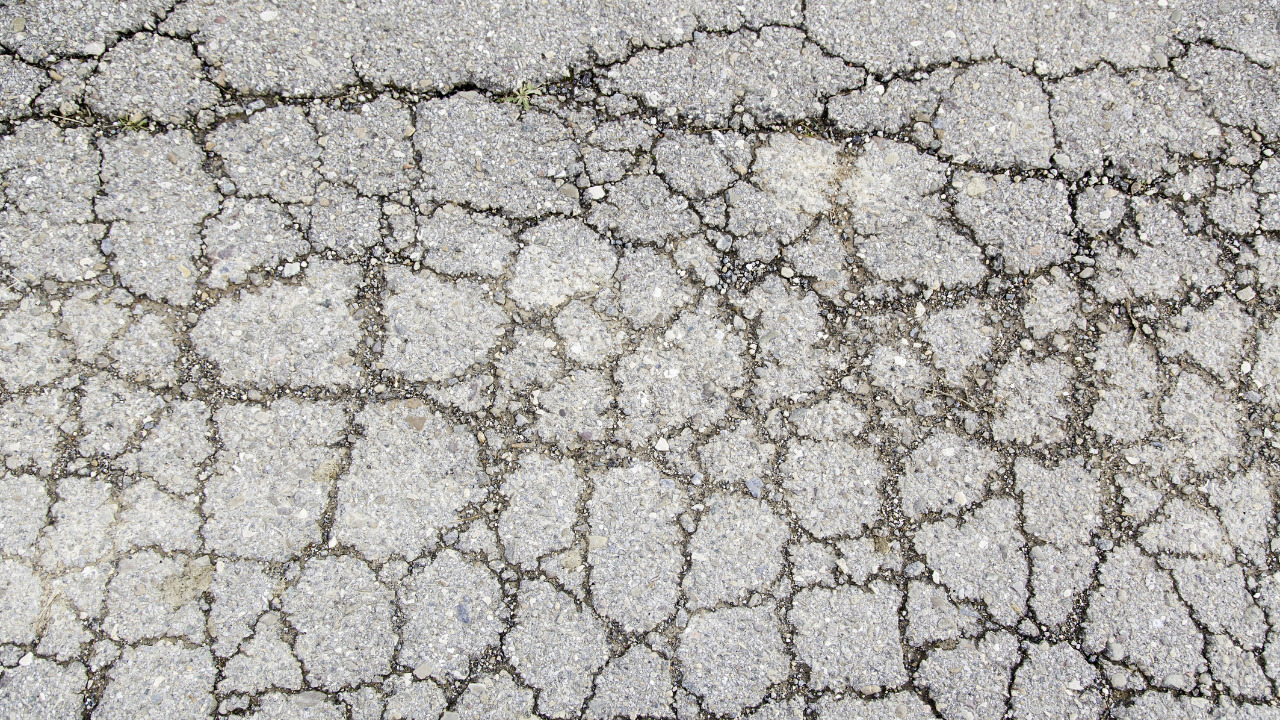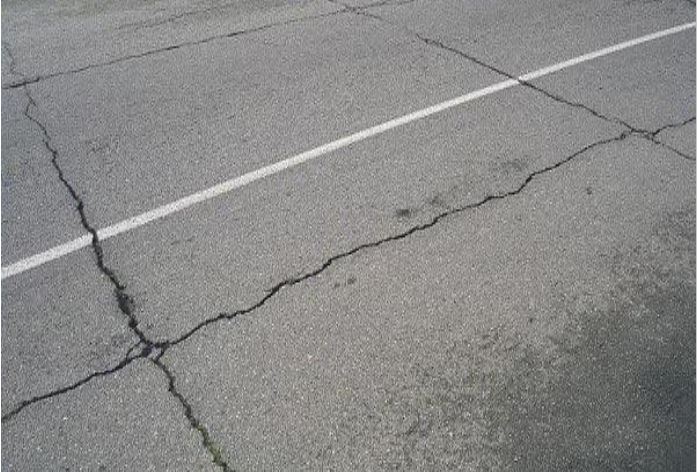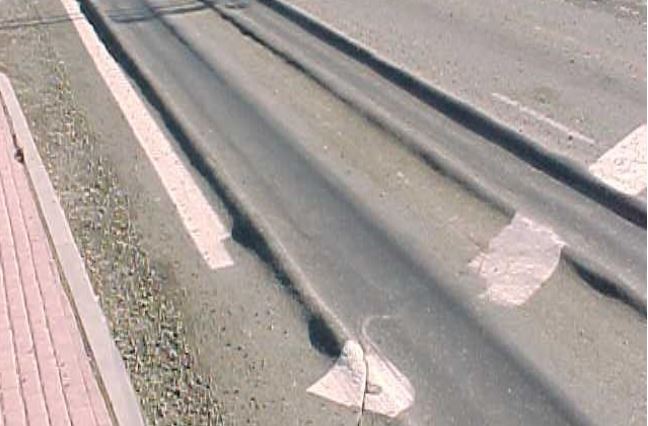Do you ever deliberate on how these freeways and motorways have made so facile for you to reach your destination without undue halts, bumps, and discomfort for vehicles and what material these roads are made of?
You might answer saying it’s a black-colored material that has small stones interlocked in it and appears as some paved pattern. Well, you have got is correct. Asphalt concrete is what you are referring to. It is an amazing paving material and we will let you know about it at length.
So, before we discuss what asphalt concrete is, let us first get to know what asphalt it.
Table of Contents
What is Asphalt?
Asphalt is a black or brownish black natural or artificial mixture in which bitumen is associated with some inert mineral matter.
The physical state in which asphalt exists depends upon the prevailing temperatures. At a temperature greater than or equal to 50 degrees Celsius, asphalt exists in a liquid state and for lower temperatures, it remains in a solid state.
The thermoplastic property of asphalt has propagated its use as a good paving material. The word thermoplastic means that asphalt softens upon heating and hardens when cooled.
Types of Asphalt
Asphalt is available in many types given as follows;
-
Natural Asphalt
Natural asphalt is also termed as ‘native asphalt’. It is obtained from lakes and can be used for paving purposes and also as a water-stopping material and in trench lining.
-
Rock Asphalt
Rock asphalt is obtained from natural rock formations that are impregnated with some good percentage of bitumen.
-
Refined Asphalt
If you heat pitch (which is a black residue or waste material of direct distillation of crude tar), the impurities and organic content will exude. The resultant material is termed refined asphalt and it contains more than 50 percent bitumen.
-
Mastic Asphalt
Mastic asphalt is obtained by adding crushed natural rock into molten refined bitumen. The mixture is agitated for around 5 hours and transferred into molds to cool. Once it cools, it gets consolidated into hard elastic blocks. These can be melted and used for the construction of pavements.
Mastic asphalt is an excellent paving material that is tough, durable, damp proof and non-inflammable.
-
Liquid Asphalt
The distillation of asphaltic crude oil to a very high temperature (around 425 degrees Celsius) leaves behind a viscous residue that is termed liquid asphalt.
-
Cut-back Asphalt
Cut-back asphalt contains bitumen with some solvents. For construction works, the asphalt has to be brought into a workable state. To do so, you either have to heat it or add some volatile solvents to bring it into a workable condition. The latter is termed as cut-back asphalt.
However, the use of cut-back asphalt has some disadvantages because of the volatile solvents being expensive and also having a negative impact on the natural environment.
-
Artificial Asphalt
Artificial asphalt contains less percentage of bitumen and is obtained once the volatile constituents of coal tar evaporate, leaving it as a residual compound.
Asphalt vs Bitumen vs Tar, Know the Difference
Bitumen is the sticky, black-colored, solid or semi-solid bonding agent produced from petroleum. It is a natural by-product of crude oil and can be located in geological formations just like oil deposits. Bitumen is used for waterproofing purposes as well as in road construction works. In North America, bitumen is termed as asphalt.
Tars are residues from destructive distillation of organic substances such as coal, wood, or petroleum. However, as a result of this process, crude tars are formed that need further refinement if they ate to be used in road works. As a result of refinement processes, they are then termed road tars. They have a pungent odor and react to weathering and temperature.
On the other hand, asphalts are the residues of petroleum oils, however, there are natural deposits of asphalt, too, that are termed “native asphalt”. They have no odor and are more resistant to weathering and less susceptible to temperature than tars. Asphalts gets dissolved in petroleum oils unlike tars.
In modern-day construction, tars are not used as binders for highway pavements.
History of Asphalt
Asphalt has been used as a binding material for thousands of years. The proto-use of asphalt dates back to the 7th century when Babylonians used it as a building material for their structural works. However, the use of asphalt in ancient times was mostly for water-proofing purposes and also for constructing roads.
With the passage of time, it was found that asphalt mixed with non-cementitious ingredients of conventional concrete (i.e., coarse and fine aggregates) can be used as an excellent material for paving works and asphalt concrete formed the basis of what is known to us an flexible pavements in contemporary road works.
What is Asphalt Concrete?
Asphalt concrete is a composite building material that comprises asphalt cement (a black colored binder) mixed with aggregates and some mineral fillers. The asphalt cement plays the role of a binding agent and provides confinement to the other ingredients. The purpose of naming this material as a category of concrete is because it is also a binding composite building material that promises strength and durability.
Asphalt concrete has a plethora of applications, majority of which can be encapsulated in the category of road works. However, there are other applications, too, that we shall discuss as we go along.
Just like traditional concrete, the proportioning of ingredients of asphalt concrete is equally important. You cannot simply mix aggregates and add the binder in quantity of your own choice. This is because asphalt cement when used to make asphalt concrete is poured hot into the dry ingredients and after a certain period of time, it hardens. The properties of the hardened mix depend upon the individual proportions of ingredients as well as their individual properties.
Types of Asphalt Concrete
-
Hot Mixed, Hot Laid Mixtures (HMA)
In this type of asphalt concrete, asphalt cement, tar or emulsified asphalt is mixed with aggregates. Prior to mixing, the asphalt is heated to about 300 degrees Fahrenheit and it is also laid when hot. Hot-mixed asphalt is durable and resistant to rutting. In addition, it can sustain high loads and wider temperatures.
-
Cold Mixed, Cold Laid Mixtures
In this type, the aggregates are mixed with emulsified asphalt, cutback asphalt, or tar and applied at ambient temperature. Cold-mixed asphalt is made for lighter use and is cheaper to apply. It is good for road repairs and resurfacing works.
Physical and Mechanical Properties of Asphalt Concrete
Since asphalt concrete is a composite material, its properties vary depending upon the proportion of ingredients that make it up. However, a general comment can be made on their properties.
Some of the physical and mechanical properties of asphalt concrete are given as follows;
-
Density
The density of asphalt concrete lies in the range of 2.2 to 2.4 grams per cubic centimeter. It is a compact material that proves to be a great choice when it comes to constructing pavements in the rural and urban spheres.
-
Color
The color of asphalt concrete is predominantly black because of the asphalt binder that covers each aggregate particle.
-
Specific Gravity
The specific gravity or asphalt concrete is between 2 to 2.4.
-
Porosity
Asphalt concrete is a porous material and its porosity can lead to defects that occur because of moisture ingress through these pores. High porosity can also impact the durability of asphalt pavements and for this reason, proper compaction is essential.
-
Flexural Strength
The reason asphalt concrete pavements are termed flexible pavements is that under the application of vehicular loads, the pavement flexes or bends. This allows asphalt concrete pavements to possess a higher flexural strength and develop greater tensile stresses.
-
Skid Resistance
Asphalt concrete possess good skid resistance and vehicles can effectively negotiate along the pavement and the braking system
-
Compressive Strength
As far as compressive strength is concerned, asphalt concrete possess comparatively lesser strength value than cement concrete pavement. However, it still bears the heavy vehicular loading effectively.
-
Fatigue Resistance
Fatigue resistance is used to indicate the ability to withstand repeated cycles of loading. Since asphalt pavements release stresses by flexing or bending, they are capable of withstanding repeated loading cycles and therefore, possess a good fatigue resistance.
-
Thermal Properties
With fluctuations in temperatures, asphalt concrete can expand and contract accordingly without cracking or disintegration. This means it possess good thermal properties.
Manufacturing of Asphalt Concrete
Asphalt concrete, just like any concrete type, requires great care from design to its placing. We will walk you through all the steps that take place when manufacturing asphalt concrete, which is usually is required in bulk quantities if a pavement extending for a longer length is to be constructed.
The following key steps should be followed so get the targeted properties of asphalt concrete.
- Just any conventional concrete, asphalt concrete manufacturing also necessitates proper mix design. This means that you need to proportion the ingredients such as asphalt, aggregates and mineral fillers.
- The aggregates are batched in storage bins and conveyed to the construction site where they are fed onto a conveyor belt. Finally, from the conveyor belt, the aggregates are transferred to a dryer.
- The aggregates are made dry by allowing hot air to remove any surface moisture present on aggregates.
- The aggregates are mixed dry and hot asphalt is poured and thoroughly mixed.
- During mixing, the mixture is heated to ensure that the asphalt binder remains workable for as long as the mixing operation is carried out.
- The prepared asphalt concrete mix is then stored in silos and transported to the plant site.
- At the site, asphalt concrete is placed and compacted to remove the voids between the bonded aggregate particles. For compaction, equipment such as roller, tampers or pavers may be used depending upon the desired level of compaction needed.
Applications of Asphalt Concrete
-
Use in Road Construction Works
Asphalt concrete is extensively used in the construction of flexible pavements worldwide. It can be used for constructing highways, freeways, arterials, and other urban roads. It provides durability and ensures longevity while bearing the heavy vehicular traffic loads. It also appreciably resists harsh weather conditions.
A flexible pavement is constructed in layers and the bulk of such a pavement is made up of asphalt concrete with base coarse underlying the asphalt concrete layer.
Concrete Road vs Asphalt Road
When we talk about durability, cement concrete roads are more durable than asphalt concrete roads. In addition, when subjected to fluctuating levels of water table and runoff intensities, asphalt roads seem to erode with time and require periodic maintenance which is nit the case for cement concrete pavements.
Cement concrete roads do not get damaged from the oils leaking from vehicles whereas oil leaks are likely to damage asphalt concrete roads.
It takes less time to lay an asphalt road than a cement concrete road. In addition. In the latter case, specialized machinery such as concrete paving machine, batching plant, transit mixer, etc. may be required and it tales more time to cure cement concrete. This boils down to increasing the project cost due to delays in construction works.
In rainy and winter season, vehicles tend to slip or slide on because of hydroplaning. This means that a layer of water intervenes between the tyres and pavement surface which reduces friction and may reduce riders’ comfort. In case of asphalt pavements, you will experience appreciable skid resistance and this makes them safer than cement concrete pavements in wet conditions.
Asphalt concrete roads allow water to seep into them and this moisture ingress may prove to be disadvantageous as it may lead to cracking and disintegration. However, cement concrete pavement provide greater resistance to moisture ingress.
Both types of pavements have demerits when it comes to impact on environment. Cement concrete pavements use cement, which is not a green material and asphalt roads use asphalt, the production of which is also not environment-friendly.
Cement concrete roads do not require frequent repairs such as patching works but asphalt concrete pavements necessitate periodic maintenance.
-
Use in Surfacing of Parking Lots
In paving and surface of parking lots, asphalt concrete serves as a good material. This is because of its durability and low maintenance requirement over time.
-
Use as a Pedestrian Paving Material
Asphalt concrete can also be used in pedestrian paving works. It can also be used for the surfacing of bicycle paths.
-
Use as a Surfacing Material for Bridge Decks
Vehicular bridges are often surfaced with a layer of asphalt concrete which not only provides good load bearing but also provide resistance to salts and other de-icing agents.
Tests on Asphalt Concrete
Just like any material, asphalt concrete is also subjected to various tests to ensure its performance and predict its behavior during its service life. Following are some of the properties of asphalt concrete that can be tested;
-
Marshall Stability and Flow Test
Marshall stability and flow test is one of the most important tests performed on asphalt concrete. This test ensures that the prepared asphalt concrete meets the standard specifications and is fit for use.
The test helps identify the optimum bitumen content for a set of known proportions of other ingredients. The stability of an asphalt concrete specimen is the maximum load it can bear without giving in or failing. The flow value is the corresponding deformation in the specimen at peak load.
-
Test for Determination of Asphalt Content
This test if used to determine the percentage of asphalt binder in asphalt concrete. This is important to know because there is an optimum value of binder content that gives the best possible results with respect to material performance under anticipated loading.
-
Gradation Test
Gradation test is used to determine the particle size distribution of aggregates used in asphalt concrete. Preferably, very coarse particles are not used and it is ensured that standard guidelines available for aggregate grading are followed.
-
Determination of Density of Asphalt Concrete
This test determines the density of asphalt concrete. Asphalt concrete is molded into molds of known volume. Once the specimen hardens, it can be weighed to find the mass per unit volume or density. The determination of density of asphalt concrete provides information about its compactness and the values can be compared with the standard specifications.
-
Viscosity Test
Viscosity of a material is the resistance it offers to flow. The asphalt binder should have a certain viscosity that should comply with the code specifications if it is to be used to prepare asphalt concrete. Viscosity test on asphalt helps determine its viscosity.
-
Moisture Sensitivity Test
Asphalt concrete should remain durable under harsh weather conditions and also when it comes into contact with moisture. To assess the moisture sensitivity of asphalt, a test is conducted to evaluate its resistance to damage.
-
Rutting Test
Rutting of asphalt concrete is a defect in pavement and it appears when asphalt concrete is subjected to fatigue stresses or repeated vehicular loading. This test evaluates the resistance of asphalt concrete to this phenomenon of rutting.
Advantages of Asphalt Concrete in Construction
For pavements and road works, asphalt concrete serves as an excellent material. Some of the prominent pros of asphalt concrete are summarized here.
- Asphalt concrete is a durable material and is capable of withstanding heavy traffic loads. Under the application of such loads, it bends or flexes and this enables it to no develop or accumulate stresses in it.
- It provides driving comfort to the riders because of a smooth surface, reducing noise and vibration.
- Asphalt concrete pavement requires lesser construction time and can be brought to serviceability quickly. This is because it does not require curing unlike cement concrete pavements and this can help speed construction work and minimize disruption to the surrounding areas.
- Asphalt concrete is comparatively less costly than cement concrete pavements and its economy coupled with high performance makes it an excellent paving material.
- It also provides excellent skid resistance and this can reduce the risk of accidents on part of the vehicles that ride on it.
Drawbacks of Using Concrete as a Construction Material
We have already discussed that asphalt concrete is the preferred option when it comes to pavement construction. However, there are a few drawbacks of using it and some of these disadvantages are also considered while designing it so that the pavement structure remains safe and durable for vehicles to negotiate.
- Asphalt concrete, as a composite material, has small interconnected voids, which can prove to be a path for moisture to ingress and damage the pavement, leading to cracking and disintegration. Therefore, if used, asphalt concrete pavement must properly be sealed by a sealant to block moisture entry. This sealant requires periodic reapplication, too, since it gets damaged due to wearing forces applied by vehicles.
- Asphalt concrete is also vulnerable to damage caused by fluctuations in temperatures. In some parts of the world, there are extreme weather conditions, either scorching heat or freezing cold. In such cases, asphalt concrete tends to expand and contract, which may cause distress and fatigue cracking if repeated such cycles take place.
- Any asphalt concrete pavement constructed so far will no be seen as crack-free. Small deformations begin to appear with time and loading intensity. In particular, the phenomenon of rutting is very common in asphalt pavements and they are susceptible to this defect. Large rutting may lead to unsightly depressions in the pavement and sometimes may even make it unsafe for vehicles to ride on it.
- With asphalt pavements, you will have limited aesthetics. This is because the color of such a pavement is generally a shade of black and you will not be able to customize its color or texture. Therefore, the pavement carpet usually offers limited liberty to tailor its aesthetic properties.
- Asphalt concrete production is not an environment-friendly process, it might actually result in increased greenhouse gases which can contribute to the rapid climate change globally. In addition, the disposal of asphalt pavements is another red signal for the environment.
- Unlike cement concrete pavements, asphalt concrete pavements require periodic maintenance and repairing. This adds up to their maintenance or running costs in order to ensure pavement longevity and proper functioning.
Design of Asphalt Concrete Pavements
The following factors are considered in determining the thickness of flexible or asphalt concrete pavements as part of their design.
- Pavement performance
- Traffic
- Roadbed soils (i.e., subgrade material)
- Materials of construction
- Environment
- Drainage
- Reliability
The structural performance of asphalt concrete is related to its cracking, faulting, raveling, etc. whereas its functional performance is related to the riding comfort (that is measured in terms of pavement roughness)
There are many methods that can be used to design asphalt concrete pavements. These include the following;
- Design of flexible pavements by US Highway Engineers Group Index Method
- California Bearing Ratio (CBR) Method for flexible pavements
- Design of flexible pavements using AASHTO (American Society for Testing and Materials) guidelines
- Design of flexible pavement using Overseas Road Note-31
Failure Modes or Defects in Asphalt Concrete Pavements
Asphalt concrete pavements are flexible in nature unlike cement concrete pavements. This flexibility is an advantage on one hand but also becomes a precursor of failure or defects in asphalt concrete pavements. Although as a material, asphalt concrete has many applications, but its major use is confined to road works because of its excellent performance as a road or pavement building material.
Following are the possible defects that you will see in asphalt pavements, some of which may take years to form while other may appear owing to human negligence or design deficiencies.
-
Fatigue (Alligator) Cracking
Alligator cracking is very common in asphalt concrete pavements and you must have seen these interconnected cracks while negotiating your vehicle on roads. These types of cracks appear due to fatigue failure of asphalt under repeated traffic loading.
It is called alligator cracking because the interconnected cracks form a pattern that resembles the back of an alligator or crocodile. Well, this sounds a little creepy; how about you go outside and inspect this cracking mode and make notes of what you have learned?
Fatigue cracking is an indicator of structural failure in asphalt pavements. These cracks create a passage for moisture to ingress and this may further deteriorate the pavement. If the cracking is localized, it can be amended by removing the cracked pavement area and replacing the underneath poor subgrade.
However, large fatigue cracking can be repaired by placing a layer of hot mixed asphalt (HMA) over the entire pavement surface.
-
Bleeding
The term bleeding in flexible pavements is used to refer to a film of asphalt binder on the pavement surface that creates a shiny, glass-like reflecting surface which is quite sticky. When a pavement with bleeding problem gets wet, the vehicles experience a loss of skid resistance when moving on it.
A possible cause of such a defect is that asphalt fills the aggregate voids during the hot weather and expands on the surface of pavement. However, when cold weather strikes, the process is not reversible and asphalt keeps accumulating on the pavement surface.
If minor bleeding appears, it can be repaired by applying coarse sand to blot up the excess asphalt binder. On the other hand, if major bleeding becomes apparent, use a motor grader or heat planer to remove the excess asphalt off the pavement surface.
-
Block Cracking
As the name indicates, block cracking indicates interconnected cracks that divide a pavement surface into approximate rectangular blocks that can have a variable size, ranging from 0.1 to 9 metric square.
The reason for such a defect is asphalt shrinkage and daily temperature fluctuations. The asphalt becomes unable to expand and shrink because of either aging or poor choice of asphalt binder in the mix design.
For cracks that are less severe and have less opening width, sealing them can help repair and prevent moisture entry. However, for high severity cracks, you will have to remove and replace the cracked pavement area with an overlay.
-
Depression
Depressions in pavements refer to a part or area having a lower elevation than its surrounding area. These become particularly noticeable after a rainfall event when water gets filled in the depressions.
The reasons these depressions form is the inadequate capacity of the underlying subgrade to bear the applied loading or insufficient subgrade compaction during pavement construction. These may also be formed by frost heave.
To repair the depressions, you need to first investigate the root cause. Once you do so, the affected area can be removed and the underlying subgrade be dug out and replaced. Finally, the repaired subgrade can be patched over.
-
Joint Reflection Cracking
If a rigid pavement such as a cement concrete pavement has a flexible overlay (such as that of asphalt concrete), the cracking in the former may lead to reflective cracking in the latter at the areas of joints.
This type of cracking becomes visible at the surface of asphalt pavements at sections where joints of rigid pavements exist. Therefore, proper surface preparation is important to prevent the onset of such cracking.
-
Longitudinal Cracking
This is also a type of fatigue cracking that is parallel to the centerline of the pavement. It makes the surface rough and may indicate the onset of alligator cracking.
The reason of longitudinal cracking is poor joint preparation. Joints in a flexible pavement are generally the least dense areas and should be constructed outside the wheel path. This is to ensure that they only get infrequently loaded by vehicular loads. However, if longitudinal joints come in the path of wheel loading, they fail prematurely and posses less resistance to cracking.
Smaller and infrequent cracking can be sealed with a sealant. However, for cracks with high severity, sealing is not an effective option and replacement with an overlay is to be done.
-
Patching
Patches in a flexible pavement are remedial measures, however, no matter how well they cover the surface, they are still a defect in the pavement. This is because they cause surface roughness.
-
Potholes
In areas where the pavements are subjected to heavy loading from vehicles, potholes are likely to appear after a few years. These are small, bowl-shaped depressions in the pavement surface that are not just confined to the asphalt concrete layer but also extent to the underlying base course.
Potholes are the aftermath of alligator cracking and are formed when a part of the pavement chunk is dislodged. To repair such a defect, different patching techniques may be considered depending upon the severity of damage.
-
Rutting
The term rutting is used to refer to surface depressions formed along the wheel path of vehicles. Adjacent to the ruts, uplifting of the pavement may become apparent. These depressions get filled with water after a rainfall event and become unsightly at times.
The phenomenon of rutting may take place in two ways; in the first way, ruts or depressions are only formed in the asphalt concrete pavement and the subgrade remains intact. Another way for rutting to take place is that both subgrade and the overlying asphalt concrete show depressions. In this case, the pavement settles into the subgrade along the wheel treads.
Ruts can be formed because of a number of reasons which include insufficient compaction of asphalt layers or the subgrade as well as heavy vehicular loads causing repeated stresses.
Pavements with slight rutting may be left unattended; however, for deeper ruts, it is essential to level the surface and provide an overlay.
-
Slippage Cracking
Sometimes you will get to witness crescent or half-moon shaped cracks in the pavement and often wonder what causes them. Well, the answer is that the braking or turning wheel wheels cause the surface of pavement to slide and deform.
Slippage cracking opens up room for moisture to infiltrate and deteriorate the pavement further. To repair such cracking, the removal and replacement method is often recommended.
-
Stripping
Stripping means the loss of bond between the aggregates and asphalt in asphalt concrete. This loss can be bottom-up or top-down. In the former case, the stripping begins at the surface and progresses upwards whereas in the latter case it is the reverse process.
Stripping of pavement is a form of pavement distress that may take place owing to a couple of possible reasons. These include the presence of water in the asphalt that prevents it from binding with the aggregate particles or the existence of an overlay that gets stripped off over time.
The possible repair for stripped pavements is removal and replacement method with adequate measures taken to account for subsurface drainage.
-
Transverse (Thermal) Cracking
Unlike longitudinal cracking that is parallel to the pavement centerline, transverse cracks are perpendicular to the traffic flow direction. They are usually caused due to thermal stresses in the pavement.
Low severity cracks can be sealed whereas high severity ones can only be repaired by removal and replacement method.
-
Water Bleeding and Pumping
Water bleeding refers to water seeping out if the joints or cracks in the asphalt concrete pavement. It may also occur is the asphalt concrete is very porous.
On the other hand, pumping refers to the ejection or water along with fine material from the underlying layers through cracks in the pavement.
If the above pavement defects are because of high water table or poor drainage, the subgrade drainage ought to be improved. However, if the asphalt concrete is porous, a surface sealant may be applied to prevent any ejection or seepage of water through the pores.
Cost Comparison of Asphalt Concrete Pavements with Cement Concrete Pavements
The cost of both these pavement types depends upon a lot of factors which include the design loading for each, the project size, location where pavement is to be constructed, material type used and the targeted strength.
However, if a general comparison is made, the initial cost of asphalt concrete pavements is less than that of cement concrete ones. As per the data shared by the National Asphalt Pavement Association, the unit square cost of the former pavements in the United States is $3 to $5 and that for cement concrete pavements is $4 to $6 per square foot.
It is also to be kept in mind that apart from the initial cost, the running cost or maintenance cost of asphalt pavements is more than that of concrete pavements. This is because asphaltic pavements require periodic maintenance such as identifying pavement defects such as potholes, rutting, etc. and repairing them, sealing cracks, resurfacing the pavement, providing an overlay, etc. Top of Form
Frequently Asked Questions (FAQs)
What is meant by skid resistance?
Oftentimes, when the surface of a pavement is wet after a rainfall event, the vehicles lose control when they negotiate on such a pavement. This is because the friction between the tyres and wheels reduces and the vehicle slides along the surface is a direction different from the intended direction of movement. This is called skidding of the vehicle.
Skidding of a vehicle often becomes apparent in the form of vehicle sliding sideways or spinning out of control or even overturing, depending upon the strength of the braking system.
Skid-resistance is an important parameter in pavement design, ignoring which can lead to accidents. The pavement material should not be such that adequate friction is lost when it becomes wet. In this regard, the performance of asphalt concrete pavements is better than that of cement concrete ones.
What is meant by asphalt concrete mix ratio?
Mix ratio is a term that is used to indicate the proportions of various ingredients that make up a particular mixture. The several components that make up asphalt concrete are asphalt, aggregates and mineral fillers.
When you devise a ratio to define the relative proportions of these ingredients as a percentage of the total volume, it is termed as mix ratio. Different mix ratios can be prepared depending upon the anticipated loading, environmental conditions, desired strength, etc.
For instance, an asphalt concrete mix can be prepared by taking 60 percent coarse aggregates, 35 percent fine aggregates and 5 percent mineral fillers. The bitumen content to be added for optimum results is first tested in the laboratory.


























